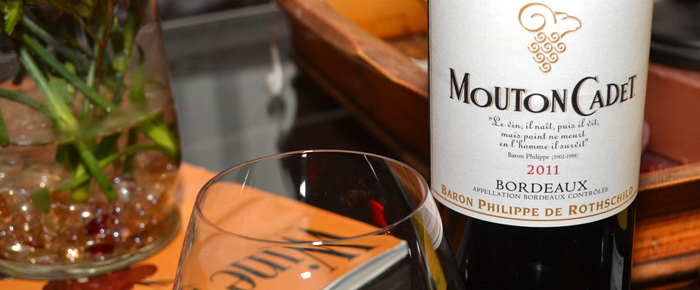
By Rick Riozza
It’s time to have some fun with Bordeaux wine.
Once upon a time, Bordeaux was a fairly serious topic. Major wine producing history kept it well respected and all business-like—sometimes, even wine-snobbery crept in (imagine that). But things are a little more balanced, now that our wine community continues to enjoy a younger crowd.
And, once upon a time, every wine drinker in town had a strong opinion on Bordeaux wine. You either loved it! or, you decided not to get into it—being happy with California or Burgundy wine. Again, a broader base of wine enthusiasts, continue to erode the need to be locked into this group or that.
The new wave of vino lovers simply see Bordeaux as yet another area of interest to taste and enjoy. They certainly wince and are amazed that so much high-end Bordeaux can sell for 500 bucks a bottle or more, but they’re not afraid of trying a cheap Bordeaux.
Since we traditionally begin to highlight and review red wines at this time of year, we may as well start anew with the largest wine district in the world. Understanding Bordeaux wine can get complicated, but we wine columnists do the best we can to keep it as simple.
Running with the simile of “Bordeaux Brotherhood”, perhaps one can grab a quick appreciation of what the wine and area are all about. Like two brothers in one family, we have the left bank and right bank Bordeaux in the Southwest of France—the area that borders the Atlantic Ocean.
No need to concern yourself with the different river names that edge the area, just remember, as when viewing a map, the area to your left of the Gironde and Garonne is the left bank, the larger area to your right of these rivers is indeed the right bank: each with their own very famous appellations.
The Left Bank lends itself to a brotherhood description: Each area has its own little terroir of soil, weather, and locale to the water that distinguishes each Château from the other—one of the wonders of the variety of Bordeaux.
Of course before we go any further, we remind ourselves of the specific varietals of grape vines that are sanctioned to be grown in the Bordeaux region. And the stars of the show are: for red wine, Cabernet Sauvignon, Merlot, Cabernet Franc, Petit Verdot, Malbec, and Carménère; for white wine, Sauvignon Blanc, Sémillon, Muscadelle, and Sauvignon Gris. So Bordeaux wine is the blending of these grapes—and each individual Château blends their own percentage of these varietals to produce their own distinct wine.
This is the original cast of old Bordeaux; and, most of us now see and enjoy how these noble vines have traversed the world to exhibit their own stellar performance: such as Cab Sauv and Merlot in Napa/Sonoma, Cab Franc in Paso Robles, Malbec in Argentina, Carménère in Chile, Sauv Blanc in New Zealand, and Sémillon in Australia and Washington State.
Back to Bordeaux, we just mentioned the left bank bros which include the names St. Estèphe , Pauillac, St. Julien, Médoc, Margaux, Graves, Pessac-Léognan, and Sauternes. The Mighty Bordeaux, both of the past and present are chateaux and producers such as Pauillac’s Lafite-Rothschild, Château Latour, and Lynch Bages; Margaux’s own iconic Château Margaux; Pessac’s Haut Brion; and of course, perhaps the loveliest sweet/dessert wine in the world, Sauternes’ own Château d’Yquem.
Running over to the Right Bank, we have its own brotherhood of famed regions that include the names Pomerol, Saint-Émilion, Libournais, and Côtes de Castillon. This right bank area contains much more limestone and clay soils than the gravelly stuff of the Left. Merlot and Cab Franc do especially well in this Right Bank soil, where we have the famous Pomerol wines such as Château Pétrus, Le Pin, and Château Clinet.
But for Bordeaux starters, why not try out the ever-popular and often ubiquitous Mouton Cadet Bordeaux Red Wine. It’s a wine produced by the acclaimed Mouton-Rothschild family which is one of the top five rated Bordeaux around. One of the best-selling wines of the world in 2002, Mouton Cadet sold 15 million bottles worldwide.
What’s great about this entry-level wine is its eight to ten dollar price range, and, it’s traditionally one of the first Bordeaux wine vintages out—so we get a clue how the overall vintage year is or will be.
My family had the opportunity this past weekend to experience the 2012 and 2013 Cadets, both of which you’ll find in the markets currently. Although the famed Mouton Rothschild Château and vineyard is in the aforementioned Pauillac region of the left bank, the Cadet bottles are often a blend of both banks, and more often, right bank grapes.
Currently, the general blend of the Mouton Cadet Red is 65% Merlot, 20%, Cabernet Sauvignon, and 15% Cabernet Franc, matured 6-10 months in oak. As I often mention in these pages, aeration is always desired, even if it’s for a few minutes. And generally, I like to aerate all red wines for at least an hour.
Again, these Cadets are “entry-level” wines, and generally the most “generic” of the early Bordeaux offerings that are light to medium bodied & young. Therefore one can limit the “breathing” time to simply pouring a large glass of wine and letting it evolve during the courses of the meal.
Both vintages exhibited an array of red fruit and dark-berry fruit. We noticed a pomegranate aroma in the 2013 and a sour cherry nose in the 2012. Black pepper began to show in the flavor profile of the 2013, while cigar-box cedar showed in the 2012. Bright acidity was present in both wines, keeping it fresh and great company to any rich dinner dish and especially one serving red meat.
It’s the deal of the day. Cheers!












































